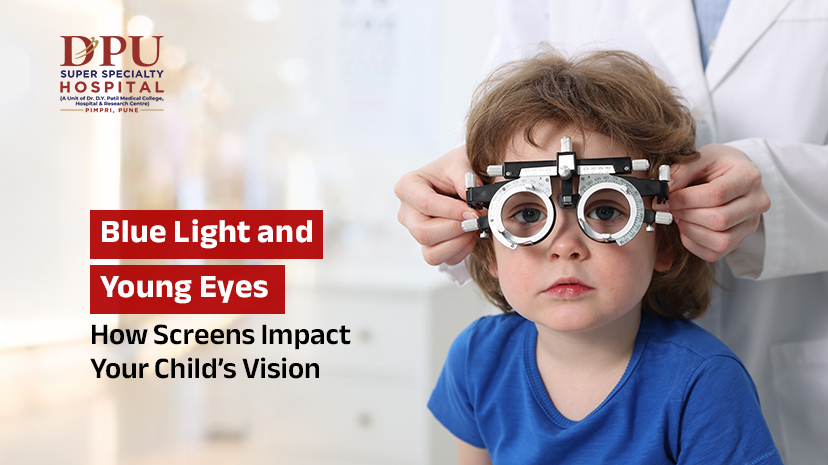Blue Light and Young Eyes: How Screens Impact Your Child’s Vision

In today's era of digital development, screen use has become part of the norm for children—to learn, for entertainment, and to socialize. However, extended exposure to blue light released by screens might have consequences related to your child's eye health and overall wellness. In the following blog, we will dive into how it affects young eyes, provide practical solutions such as the 20-20-20 rule, and explain the ways our pediatric specialists can guide your child on eye health maintenance.
1. How Blue Light Affects Your Child’s Developing Eyes: What Parents Need to Know
As more and more time is spent on screens, the parents must learn how their children are exposed to blue light from a device, be it smartphone, tablet, computer, or television, has a potential to impact their eyes. Blue light penetrates deeper into the eye compared to all other forms of light. This can have some serious effects on the vision of a child:
- Eye Strain: Prolonged exposure to blue light can cause digital eye strain. Symptoms include dryness, irritation, blurred vision, and headaches. Children may struggle to communicate these symptoms, but they can experience discomfort, especially during extended screen time.
- Disrupted Sleep Patterns: Blue light affects the production of melatonin, the hormone that regulates sleep. Exposure to blue light, particularly before bedtime, can interfere with your child’s natural sleep cycle, leading to difficulty falling asleep and reduced sleep quality.
- Long-Term Vision Health: There is ongoing research into the long-term effects of blue light on young eyes. Although blue light itself is not harmful, prolonged exposure over time may contribute to the development of conditions like macular degeneration, a condition that affects central vision later in life.
2. The 20-20-20 Rule: A Simple Habit to Protect Your Child’s Eyes During Screen Time
One of the ways to avoid eye strain caused by screen use is the 20-20-20 rule. This is one of the easiest techniques for encouraging your child to take breaks during screen use and thus avoid overloading their eyes with strain.
- How It Works: Every 20 minutes, encourage your child to look at something 20 feet away for at least 20 seconds. This practice helps relax the eye muscles and reduces the strain caused by prolonged focus on a screen.
- Why It’s Effective: Looking at distant objects allows the eyes to refocus, giving them a break from the close-up strain of screens. This quick habit helps prevent discomfort and supports healthy eye function.
- Making It a Routine: Parents can help instill the 20-20-20 rule by setting timers or reminders to ensure their child adheres to this practice. Additionally, it can be a fun activity if paired with stretching or moving around during breaks.
3. How Blue Light Affects Your Child’s Brain and Focus
Blue light exposure not only affects eye health but also impacts your child’s brain and ability to focus. Here’s how:
- Cognitive Disruption: Excessive blue light exposure, especially at night, can interfere with your child’s cognitive function. As it suppresses melatonin production, it can make it harder for children to concentrate and retain information, particularly before bedtime or during homework sessions.
- Decreased Attention Span: Prolonged screen time has been associated with reduced attention span and increased distractibility in children. Blue light exposure may exacerbate this issue, making it harder for them to focus on tasks or schoolwork.
- Mood and Behavior: Disrupted sleep patterns due to blue light exposure can also affect your child’s mood and behavior. Poor sleep can lead to irritability, mood swings, and difficulty regulating emotions.
4. How Our Pediatric Specialists Help Manage Your Child’s Health
At our pediatric practice, we understand the importance of managing your child’s health, especially when it comes to eye care in the digital age. Our pediatric specialists are here to support you and your child in the following ways:
- Comprehensive Eye Exams: We offer thorough eye exams to assess the health of your child’s eyes and detect any early signs of digital eye strain or other issues. Early intervention is crucial to ensuring your child’s vision develops healthily.
- Screen Time Guidelines: Our specialists provide personalized recommendations on safe screen time limits, taking into account your child’s age, activity levels, and overall health. We guide families on how to incorporate healthy screen habits, like the 20-20-20 rule, into daily routines.
- Vision Protection Tools: We recommend the use of blue light-blocking glasses or filters for screens, which can help reduce the amount of blue light exposure. Our team can advise on the best options for your child based on their needs.
- Behavioral Support: Beyond physical eye care, we offer advice on helping your child manage their screen time to reduce its impact on sleep, focus, and behavior. Our specialists work with parents to create balanced routines that promote healthy development.
Conclusion
While screens are an essential part of modern life, managing their impact on your child’s eye health is crucial. Understanding the effects of blue light, incorporating habits like the 20-20-20 rule, and seeking guidance from pediatric specialists can help protect your child’s vision and overall well-being. By taking proactive steps, you can ensure that your child’s eyes stay healthy and that they continue to thrive in the digital world.








